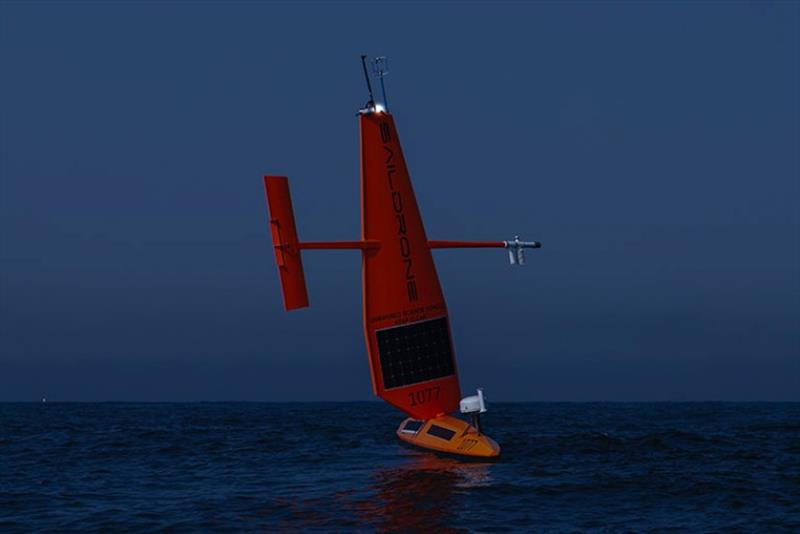
Spooky sounds at sea: Listening for bats offshore with USVs
by Saildrone 26 Oct 2023 07:07 PDT

A Saildrone Explorer equipped with an ultrasonic microphone spent a month surveying near South Farallon Island, an area known as a migratory bat roost © Saildrone
There are more than 1,400 species of bats, and bats make up about 25% of all mammals. In North America, bats contribute about $23 billion in pest control services to the agricultural industry.
Around the world, bats are crucial for pollination and seed dispersal and consume insects that transmit diseases. But, bats are under threat from habitat destruction and other human activities.
Bats aren't actually blind, they have extremely sensitive eyes that allow them to see in the dark. But to navigate and hunt, most bats use sound. Known as echolocation, bats listen to the echoes of their ultrasonic calls bouncing off their prey—fishing bats have echolocation so sophisticated they can detect the fin of a minnow protruding only two millimeters above the water's surface.
Saildrone and Bat Conservation International (BCI), a global conservation organization dedicated to ending bat extinctions, have completed a first-of-its-kind mission to study bats in an offshore environment using the bats' own echolocation calls.
Bats have been known to fly from the US mainland to Hawaii in about three days, at an average speed of 60 mph, and, flying at speeds up to 100 mph, the Mexican free-tailed bat is the fastest bat in the world.
The US Geological Survey studies bat roosting, disease, long-distance movements, and migratory bat species like the hoary bat, the silver-haired bat, the western red bat, and the Mexican free-tailed bat along the US West Coast and offshore. Offshore sites are typically deployed on coastal rock formations, which are difficult to reach and maintain.
Saildrone and BCI equipped a Saildrone Explorer with an ultrasonic microphone, mounted at the top of the wing. Saildrones are deployed from any dock and transit autonomously to and from the area of operation. Powered by wind for propulsion and solar for onboard sensors, they are virtually silent and have a zero operational carbon footprint.
From September 2-October 2, the saildrone sampled near a known offshore bat migratory roost on South Farallon Island, approximately 25 nm west of the Golden Gate Bridge. Over 31 nights, the saildrone recorded over two hours of bat activity—965 bat calls across five known species, including 276 hoary bats and 209 Mexican free-tailed bats.
"With a zero operational carbon footprint, no impact to the marine ecosystem, a diverse payload, and the ability to stay at sea for extended lengths of time, Saildrone is ideally suited to provide never-before-collected information about offshore bat migration patterns. This important information will allow us to understand and minimize the potential impacts of offshore wind energy development on bat populations," said Michael Whitby, BCI director of Bats & Wind Energy Program.
The mission is funded by the Department of Energy in collaboration with EPRI, an independent, non-profit energy research and development organization. The goal is to help demonstrate the viability of the Saildrone platform as a tool for bat research and environmental impact assessments to evaluate the risk of offshore wind energy development to bats.
"The need to monitor bats in the offshore environment is increasing," said Christian Newman, technical executive for environmental aspects of renewables, EPRI. "EPRI's expertise and focus on collaboration supports the project team well, helping test a new type of technology that can help fill in data gaps for offshore wind decision-makers."
Renewable energy solutions like offshore wind are seen as a key element of reducing global demand on fossil fuels. BCI works with diverse partners, including the offshore wind industry, to facilitate renewable energy while minimizing impacts on bat species and develop technological tools to better understand and minimize fatality risk to species at proposed OSW sites.
Saildrone USVs also carry a standard suite of science-grade instruments to collect meteorological and oceanographic data. This data is useful for better understanding bat behavior, what conditions put bats more at risk for collisions, and providing environmental data for modeling potential offshore wind sites.
Saildrone's underwater acoustic data collection includes surveys of fish biomass for sustainable fisheries management and has previously used sound to track sharks, marine mammals, and crustaceans. The company is currently developing new underwater acoustic technology to detect, classify, and localize marine mammals, especially whales, which are highly sensitive to underwater noise.
"Saildrone's quiet platform has long been valued for underwater acoustic research, and we are thrilled to leverage it in this new way to help protect the world's bat populations," said Cristina Castillo, Saildrone Sr. Program Manager for Ocean Data Programs.